|
 DISCOVERY
OF NAINITAL :-
DISCOVERY
OF NAINITAL :-
The names of two foreigners is linked with the discovery of the
Lake at Nainital. One of them G. W. Traill, Commissioner of Kumaon
and Garhwal, was the first European to set eyes on it in 1823. Nevertheless,
the lake had been known for quite some time to herdsmen from villages
nearby and held in great reverence as an abode of gods and spirits.
|
|
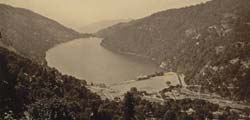 |
|
G. W. Traill had great respect for the traditions and beliefs of
the hill folk. To his way of thinking, crowds would violate the
sanctity of the place and the lake, so he kept the discovery of
the Nainital Lake strictly to himself.
|
|
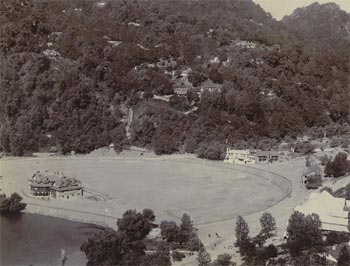
|
|
On
the other hand, Mr. P. Barron, a European merchant and an enthusiastic
hunter from Rosa, near Shahjahanpur, had no sooner caught a glimpse
of the lake in its sylvan setting than he realized its potential
as a hill resort and went full steam a colonizing it. Mr.P.Barron
was the second European who took great fancy to this land. Moved
by the beauty of the sparkling lake he wrote: "It is by far
the best site I have witnessed in the course of a 1,500 miles treak
in the Himalayas"
The year was 1839. Barron first reached the lake through a trick,
a fact mentioned in his book Wanderings in the Himmala. He knew
there was a large lake in the heart of Kumaon. He also knew that
local guides deliberately misled Europeans who wished to go there,
in order to keep the location a secret. Sure enough, Barron's guide
declared he had never heard of the lake, at which Barron placed
on the guide's head a large stone and told him to carry it till
they managed to find the lake. He said there were reputedly no stones
near the lake and he needed come to build a house.
|
|
Desperate to be rid of the load, the guide soon confessed he knew
the lake well enough and there was no scarcity of stones in the
general area. Barron says that other Europeans also resorted to
the same trick till such time that Nainital found a place on the
map.
|
|
On his second visit, Barron got the better of a local thokdar (village
headman) Nar Singh who had laid claim to the lake and the surrounding
hills as his ancestral property. The matter was pending settlement
in court. Barron persuaded Nar Singh to accompany him for a ride
on the lake in his (Barron's) own private boat, a rarity in those
days. In the middle of the lake, Barron threatened to upset the
boat if Nar Singh did not waive his claim, thereby admitting the
right of the honorable Company Bahadur to the disputed land.
Nar Singh had no choice for, unlike the others, he could not swim.
He wrote the needful in pencil on the page of a pocketbook provided
by Barron. Mission accomplished, Barron promptly applied for a plot
to construct a house.
|
|
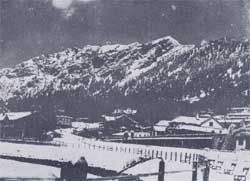 |
|
Land was allotted for the purpose just above the present Nainital
Club at an annual lease of two annas! Here, Barron constructed the
house Pilgrim Lodge, his pen name being Pilgrim. The house stands
to this day.
|
|
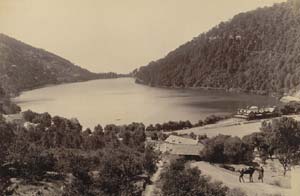
|
|
Nainital
was Jim Corbett's home for many years. Though Nainital had expanded
and the surrounding forests that once teemed with bears, tigers
and deer, the soul remains the same. Nestled in the serene and peaceful
hamlet of beautiful lakes and mountains, watch the sun rise and
set over the mountains of Nainital. Move across the ravines and
valleys, and see localized weather patterns appear over the higher
peaks as winds are driven upward.
Blessed with picture perfect and varied natural resources.
The Nainital town became the summer headquarters of the colonial
administration of the province. It was a popular retreat for the
residents of the plains.
|
|
Being
popular with the British, the town developed a British character
with several European schools, barracks, a sanatorium and a race
course, of which this is a view.
|
Massive
Distruction Faced By the Nainital Region (Nainital Landslide 1880)
|
|
In Sept 1880 a landslide occurred at the north end of the town,
burying 151 people. The first known landslide had occurred in 1866,
and in 1879 there was a larger one at the same spot, Alma Hill,
but "the great slip occurred in the following year, on Saturday
18th Sept 1880. "Two days preceding the slip there was heavy rain.
20 to 25 inches fell during the 40 hours ending on Saturday morning,
and the downpour still lasted and continued for hours after the
slip. This heavy fall naturally brought down streams of water from
the hill side, some endangering the Victoria Hotel, Bell's shop,
the Volunteer Orderly Room and the Naina Devi temple were scenes
of labour with a view to diverting streams.
At a quarter to two the landslip occurred burying those in and around
the buildings mentioned above." The total number of dead and missing
were 108 Indian and 43 British nationals.
|
|
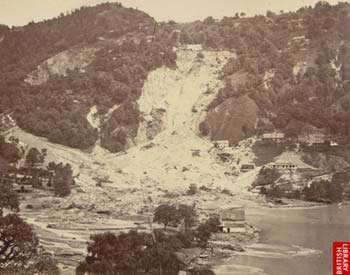
|
|
The Assembly Rooms and the Naina Devi Temple were both destroyed
in the disaster. A recreation area known as 'The Flats' was later
built on the site and a new temple was also erected. To prevent
further disasters, storm water drains were constructed and building
byelaws were made stricter.
|
|
Nainital the ' Lake District
of India' has been privileged with as many as 60 lakes.
With the passage of time some 40 lakes disappeared
because of deforestation, pollution and a general lack of awareness.
|
|
MYTHOLOGY ABOUT NAINITAL
It
is very less is known about the history of Nainital. This region
was called "Khasdesh" in ancient times and
"Khasis" ruled this region before Christ
was born. Once
the Nainital area had many lakes and it was called the City of 60
lakes or 'Chakta' The Nainital Lake finds mention in the
Manas Khand (chapter) of the Skanda Purana (scriptures) as the Tririshi
Sarovar, i.e., the lake of the three sages (or rishis).
Atri, Pulastya and Pulaha. Legend has it that in the course of their
pilgrimage the three sages arrived here, only to find the place
without water. Meditating on the sacred and bountiful sanctum lake
of Tibet namely Manasarovar Lake, they dug a hole here. So great
was the power of their tapasya (meditation) that the
hole soon filled with water.
According to a legend King Daksha held a great 'Yajna'
but did not invite Parvati and her consort Shiva. Parvati could
not bear this direct insult, in her great fury Parvati gate-crashed
into the 'Yajna' ground and leaped into the high flames
of 'Yajna' fire to end her life and later Lord Shiva
retrieved her half-charred corpse himself. His Chakra and cut the
Sati’s body into fifty one pieces to save the earth from Shiva’s
wrath. All the fifty one places - where parts of Sati's body fell,
became known as Shakti Peeths.
It is said that the shimmering green waters of the Naini Lake is
a reflection of the emerald green eye of Sati. The majority of the
local people believe that the eyes of Sati dropped in the
lake while her body was being carried by Lord Shiva to Kailesh Parvat.
Hence, the lake was given the name of 'Nainital' or
Naini lake. Later the spot became famous by this very name.
MYTHOLOGY
OF NEAR BY PLACES IN NAINITAL DISTRICT
There
are many places Dev Bhoomi Uttarakhand which have religious connection
Epics like MAHABHARATA and RAMAYANA.
It is said that Padava spent their 14 yrs of exile in Uttarakhand.
They constructed several temples in Uttarakhand
during their stay here and finally they went to Heaven from the
Uttarakhand itself. There are several places in Uttarakhand
which have connection with Ramanayana also.
Mukteshwar (Nainital District)
Mukteshwar has served as a retreat and also carries much religious
significance. According to local belief and folklore the Pandavas
as well as many gods and Devtas of the Hindu pantheon have graced
it with their presence.
Bhimtal
(Nainital District)
Bhimtal, earlier known as Bhimsarovar, is believed to be the stamping
ground of the Pandavas. According to the locals the town is named
so because when the Pandanvas had been exiled in this region they
could not find a water body from which they could quench their thirst.
It was then that Bhima, the powerful, hit the ground with his "gada"
or club thus creating a cavity in the ground, which was filled with
an underground source of water. The Bhimeshwar temple is said to
have been set up by the Pandavas, who established a Shivling there.
Sattal (Nainital District)
Religious beliefs pertaining to the Sattal lakes go back to the
times of the Mahabharata. The Nal Damayantital is named after King
Nal. King Nal, one of the most famous kings of Hindu mythology,
was sentenced to a fourteen year exile by his brother, Pushkar.
Penniless and ostracised, he and his wife Damayanti sought refuge
in Satal, among other places.
Seeta Bani Temple (Nainital District)
Seeta Bani Temple is dedicated to Devi Sita, consort of Lord
Rama. Sita was a foundling, discovered in a furrow in a ploughed
field, and for that regarded as a daughter of Bhumi Devi, the goddess
of the Earth. It is believed that at the end Devi Sita entered into
the lap of Mother Earth from here. Every year, a fair is held here
during Ram Navami. It is located at a distance of 20 km from Ramnagar.
|
|
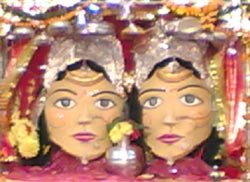
|
The name "NAINA"
which means eye is derived from a temple to
the goddess 'Naini Devi" built on the upper edge of
the lake and was destoyed by the landslip of 1880.
It was subsequently replaced by the present structure. The word "Naini"
means 'Eyes' and 'Tal' means 'Lake'.
The perimeter of the Naini Tal lake is of nearly 2 miles. |
 Maa
Naina Devi Temple is considered to be one of the most revered Hindu
Temples in India Maa
Naina Devi Temple is considered to be one of the most revered Hindu
Temples in India
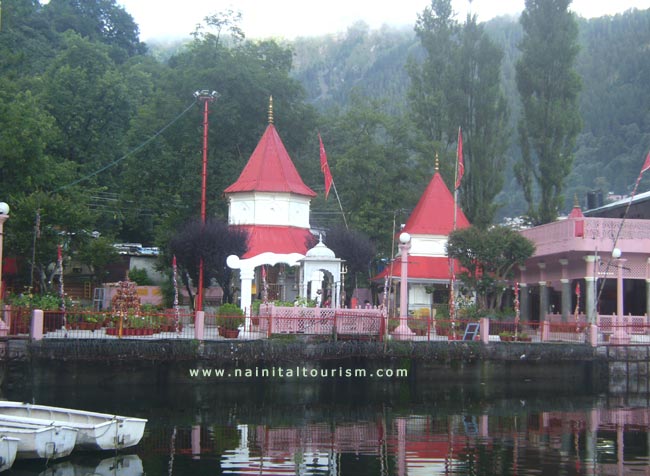 |
|
Though the Naina Devi temple is named after Naina Devi (another
name for Sati), the biggest social occasion here is the festival
held in honour of Nanda Devi.
The patron goddess of Kumaon hills and a local princess
Sunanda Devi.
On
the northern side of the lake is built a temple dedicated to Sati
and is called
the Maa Naina Devi temple.
The
Naina Devi temple is situated atop Naina hillock in Nainital. Thousands
of pilgrims gather here every year around September to worship Goddess
Parvati.
|
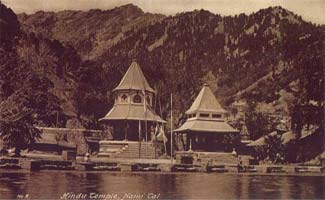 |
 Maa
Naina Devi Temple is considered to be one of the most revered Hindu
Temples in India Maa
Naina Devi Temple is considered to be one of the most revered Hindu
Temples in India
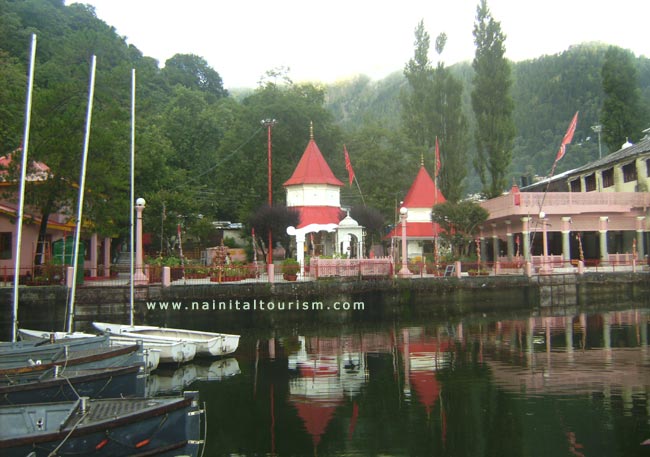 |
 Maa
Naina Devi Temple is considered to be one of the most revered Hindu
Temples in India Maa
Naina Devi Temple is considered to be one of the most revered Hindu
Temples in India
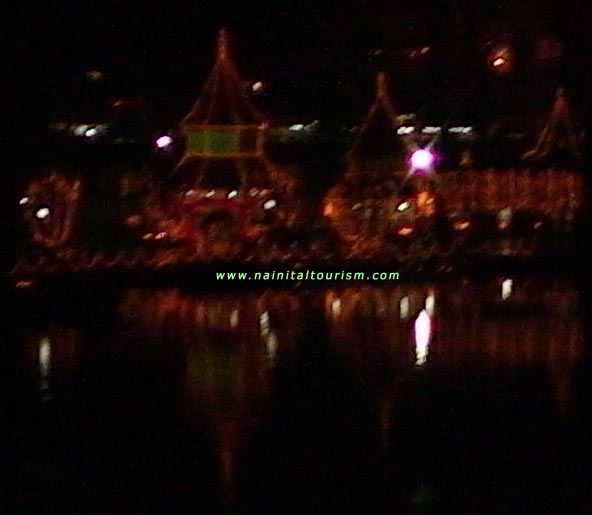 |
|

